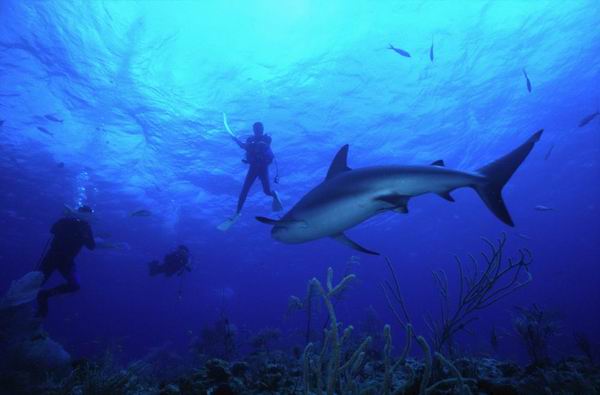
Shark
Fest
By Phil Maranda
Shark attacks can happen in the blink of an eye or in this case, the snap
of a shutter. Kneeling in the sand 40 feet beneath the ocean waves while
30-plus frenzied Caribbean reef sharks battle for a scrap of fish three
feet in front of my face tends to up the odds. Determined to snap a photo
of a large female at the precise moment she snatches the bait—despite
my sense of impending doom—I raise the Nikonos-V camera to mask-level
and fire; the strobe’s blinding flash explodes into the subdued
light of the Atlantic, and a split second later, all I see is a mouth
full of razor-sharp teeth. This is it! I’m shark bait for sure!
* * *
The warm, humid air that caressed my face as I stepped off the plane in
Nassau, Bahamas felt like heaven. It was February, and like many of my
fellow Canadians, I’d grown tired of another long, cold winter.
I decided to jet away to el Caribe for a quick vacation in the sun and
what promised to be an extreme week of diving with Caribbean reef sharks
in one of the world’s premier locations to participate in a shark-feeding
dive. A couple of the Bond movies were filmed in the Bahamas, and although
I didn’t possess the titanium chandeliers of 007 when it came to
swimming with sharks, I was looking forward to it just the same.
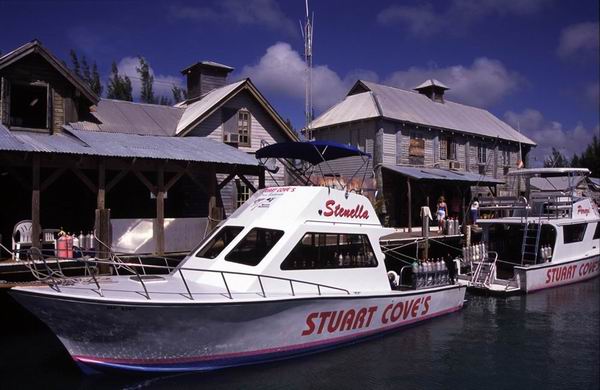
Sitting on the boat as it cruised towards a dive site known as Shark Wall,
a day and a half later, all I could think about was what it would really
be like to fulfill a dream I’d entertained for nearly 15 years—fear
or not, I was finally going to dive with sharks. The seas were rough,
thunderheads were blowing up on the horizon, and as we approached the
dive site, my excitement, mixed with a major dose of apprehension, mounted
to near adrenaline-rush levels.
When we arrived at the wall—10 miles out from New Providence Island—which
was represented topside by a couple of mooring buoys bobbing in the expanse
of the turquoise waters of the Atlantic, there were already a couple of
sharks cruising towards the boat. They must recognize the meal wagon,
I thought as the dive instructor told everyone to suit up.
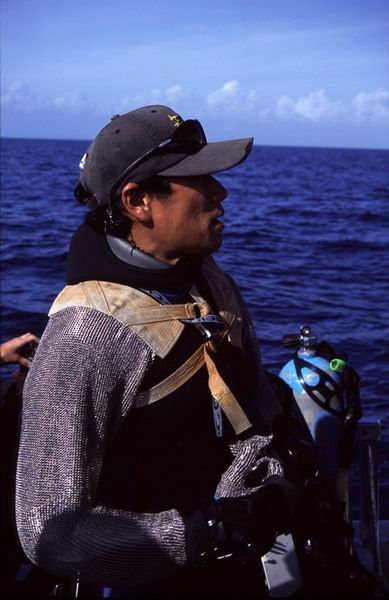
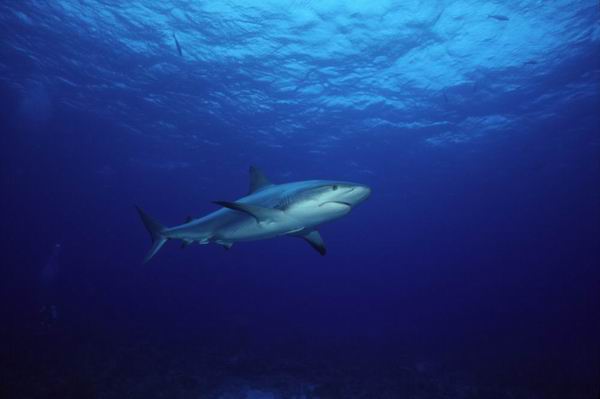
By the time our group of 15 anxious divers was ready to go, dorsal fins
were breaking the water all around the boat. Watching this spectacle made
it hard for me to focus on dive instructor Tohru Yamaguchi’s pre-dive
briefing. At first I caught something about the wall being down around
70 feet and that we’d be underwater for roughly 30 minutes, but
then Yamaguchi mentioned something that snapped me to attention and began
to ease my fear. “Caribbean reef sharks don’t eat meat, only
fish. I’ve taken a piece of chicken down with me, and the sharks
won’t go near it,” he said. “But just make sure you
don’t touch a shark or wave your arms in front of the sharks.”
After doing final checks to the gear, it was time to go, and one after
another the group jumped into the water via the back platform of Stuart
Cove’s 40-foot, custom dive boat. Before slipping beneath the waves
myself, I grabbed a Nikonos-V camera (that I’d rented back at the
dock) from Karyn Wilde, an underwater photographer from Vancouver, B.C.
who worked in Stuart Cove’s photo shop. Wilde had given me a bit
of advice on getting close-up shots of the sharks when we were back on
dry land. “Sharks are easy to photograph,” she’d mentioned
with a slight smile. “We usually put a fish in our pockets if we
want the sharks to get really close. But don’t take it out and wave
it around or the shark will come up and bite you trying to get at the
fish.” Thanks, but no way, I’d told her.
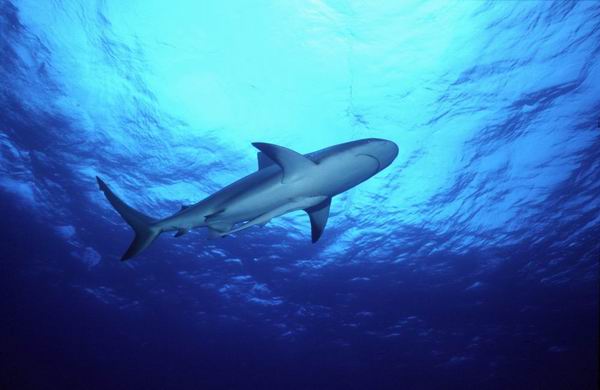
Deflating my buoyancy compensator, I began to descend, and the second
my mask was underwater I could see a dozen sharks cruising around the
boat, some of them heading right towards me. I tried to relax by taking
a deep breath and letting it out real slow, but it wasn’t until
the first big reefer passed by about three feet away that I realized at
least this one didn’t want me for lunch.
Continuing down towards our meeting point, I was really amazed by how
many sharks were in the area. Each one seemed to be moving at the same
speed as if they were set on cruise control. The fact that light dissipates
quickly underwater helped to add to the surreal feeling of the whole event.
The sharks just materialized out of the darkness, slowly becoming clearer
as they drew near. The first motion I could pick out of the gloom was
the snake-like movement of their bodies caused by the swish of their powerful
tails propelling them through the deep blue.
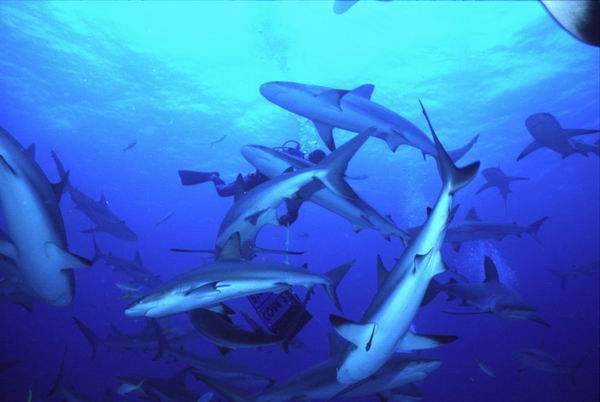
Caribbean reef sharks use their tails not only for propulsion but also
to make sudden changes in direction when they’re hunting or fleeing.
When provoked, these perfectly designed killing machines can move with
blinding speed. Adult reefers range in length from six and a half to just
over 8 feet, the females being larger than the males. They can smell blood
in the water from miles away and have amazing hearing, capable of making
out the thrashing sounds of an injured fish from over a half-mile.
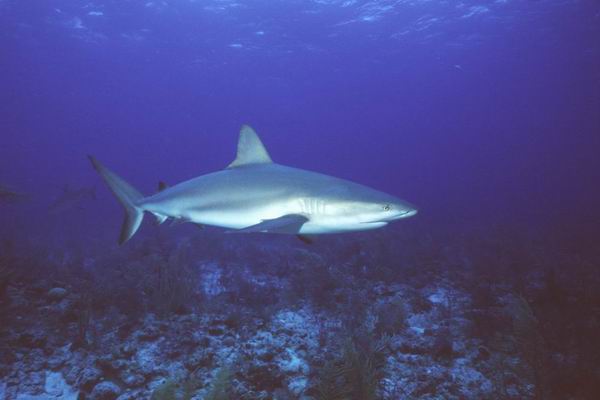
When I arrived at the rendezvous point, the rest of the group was ready
to go, and Yamaguchi began leading us along a reef rich with coral, sea
sponges, and other marine flora and fauna. Brightly-colored fish of all
sizes and shapes darted in every direction while giant groupers meandered
by, seemingly undeterred by the presence of the divers who’d invaded
their domain
.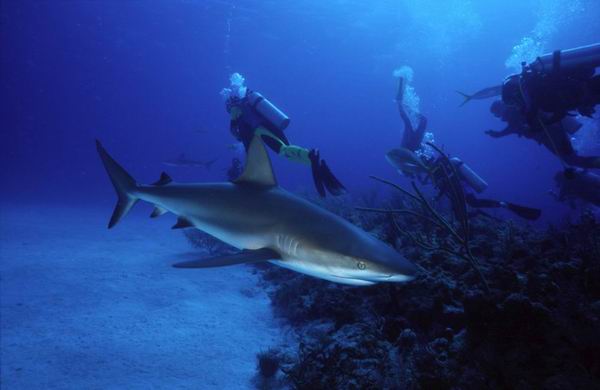
Caribbean reef sharks were everywhere, swimming up and down the reef like
they’d been asked to join our group cruising along the wall. The
sharks swam so close to us that it would’ve been a breeze just to
reach out and touch one, and as they passed by they eyeballed me until
it started to feel like I was on the other side of an aquarium glass,
and they were looking in on me. Struggling to break the spell, I forced
myself to focus on the camera grasped firmly in my right hand and on making
pictures.
At that moment a large reefer appeared, heading straight for
me, and so I tried to remember what tips (besides the fish in the pocket)
Wilde had given me then raised the camera and took my first shot. When
the strobe fired it startled both of us, and for a split second I thought
I saw the shark blink before it moved off at a slightly accelerated pace.
Thirty minutes pass quickly underwater, and soon we were back on the boat
getting ready (after a brief rest) for the second dive. This was the one
that everybody was really there for—the shark feeding. Yamaguchi
laid it all down in his pre-dive briefing about how we should make our
way to the bottom by following the anchor line attached to the front of
the boat. Once we were at the anchor, we were to swim to a sandy circle
known as the Shark Arena.
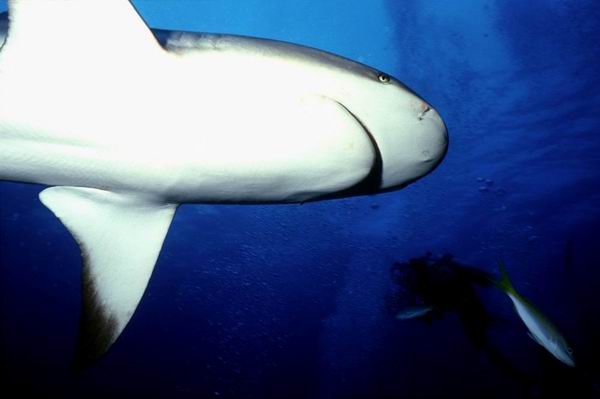
“When you get to the Shark Arena, kneel down, and remember, don’t
touch the sharks. Don’t wave your arms around because on this dive
there will be many more sharks, 30 or 40 of them. If you do move your
hands abruptly, the Caribbean reef sharks could mistake them for bait
and bite you. Your hands are pretty close to the same color as the fish
heads I’ve got in the feeder,” Yamaguchi said. Finishing up
his briefing, he again stressed the importance of making sure that we
were planted on the bottom in a stable position and kept our movements
slow.
Before we entered the water, Yamaguchi threw fish heads over the side,
and we all watched as sharks began to swarm around the boat. There were
only a few at first, but within minutes, fins were breaking the surface
everywhere I looked. This time the dorsal fins of the sharks didn’t
seem nearly as threatening as before. So the minute I was ready to go,
I jumped in, resurfaced to grab the Nikonos-V from Wilde, then descended
and made my way to the Shark Arena.
On the way to the bottom I watched the sharks swarm around each diver,
looking to see if they might be carrying the bait. But when the reefers
realized there was no food, they swam off to the next person and then
the next. Once we made it to the Shark Arena and had formed a semi-circle
on the sandy bottom, Yamaguchi was bringing down the bait box. The sharks
made a beeline right to him and were making no mistake this time as they
followed the veteran shark wrangler while he made his way to our position.
The moment Yamaguchi landed on the ocean floor, the sharks moved in, showing
a great deal more aggression than on the previous dive. They bumped and
pushed each other out of the way as they jockeyed for position around
the feeder. Although our guide was probably right about the number of
reefers, there seemed to be many more as they pushed past us to get at
the first piece of fish that Yamaguchi pulled from the feeder. At that
moment I knew exactly why we were supposed to be planted firmly on the
bottom since the sharks nearly upended several members of our group including
me.
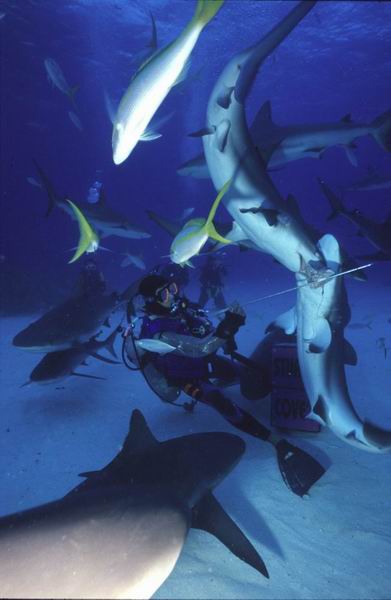
A large female was the first to take the bait, and as she was tearing
it off the metal skewer, I could see her eyelid close and then reopen
again as she moved off, still thrashing with the bait half in her jaws.
With each new fish head that our guide produced, the frenzy heightened
until all I could see were fins, snapping jaws, and dozens of reefers
at once all battling to be the first to the skewer that Yamaguchi held
in his armor-clad hand.
The feeder was completely emptied by the Caribbean reef sharks in 10 or
15 minutes tops, and then it was time to head back to the surface. The
sharks seemed to calm down almost instantly as Yamaguchi lifted off the
bottom. Most of the reefers disappeared as quickly as they had arrived
while others still interested in our guide took up following him to the
surface. Meanwhile, some of the divers in our group who’d been on
shark dives before began to rummage through the sand looking for shark
teeth while I waited for the adrenaline which was coursing through my
veins like a raging river to subside enough so I could make my way back
to the boat.
On the second day of shark diving, Yamaguchi decided we should dive a
little closer to shore due to the seas being much rougher than before.
And once we’d completed the first shark dive—which seemed
really tame compared to the day before—I found myself back on the
boat getting ready for another shark feeding.
Yamaguchi wanted to give me an extra thrill by allowing me to get closer
to the action so I could make some full-frame images of the sharks. He
handed me the same radical-looking, knights-of-the-round-table-like, chain-mail
armor that he used to protect himself from shark bites during the feedings.
I slipped it over my slimy-feeling, already wet suit before donning the
rest of the gear and getting ready to enter the water. Within a few minutes
I was underwater juggling the Nikonos-V in one slippery, metal-covered
hand and was heading towards the feeding area.
At the bottom, Yamaguchi instructed me to move in three feet from the
feeder. When I was planted firmly on the sand, he speared the first fish
head and extended it out in front of my face. There wasn’t much
time to react as the sharks rushed in, and I was lost in the middle of
the fray.
Then I saw Yamaguchi spear another fish head. Once again he stuck it right
in front of me, but this time—despite my mounting fear of getting
bit—I managed to raise my camera just as a big female reefer rushed
towards the feeder. With blinding speed she hit the skewer, and at that
instant I somewhat aimed the camera and fired.
* * *
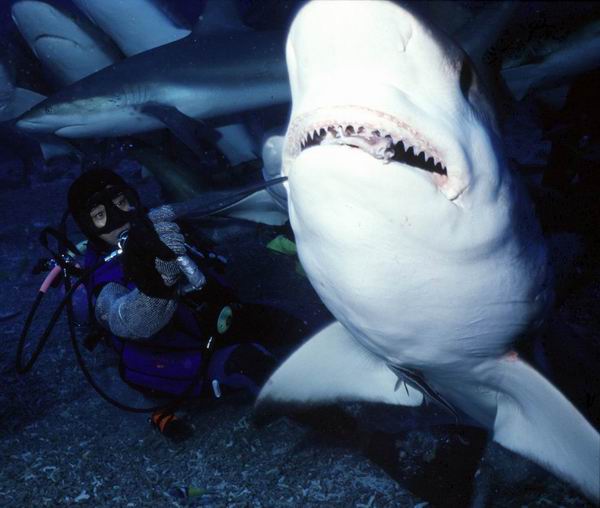
For a split second the light blinds me, and then all I see is a set of
razor-sharp teeth bearing down on me through the camera lens. There’s
no time to move so I do the only thing I can and brace for the impact
of a shark attack. Suddenly my mask gets knocked off, my camera is nearly
torn from my hands, and I feel myself rearing back from the blow. I can’t
tell if I’m bleeding or if the chain mail deflected the bite, and
I can’t even tell if I’ve been bitten at all.
A few moments pass in an eternity, and then I start to take stock of what
has just happened. I quickly reposition my mask and then clear it of water
so I can once again view what is going on around me. Looking down I can
see no blood pouring from an open wound and no signs of any other real
damage. The strobe on the camera has taken the worst hit and has been
knocked out of position. Readjusting the light, I take a few deep breaths,
a couple of steps backwards, and then return to watching the shark- feeding
frenzy.
By the time Yamaguchi and the sharks are done, I’ve spent all my
film. This time I follow the guide back to the boat; all the sharks are
still trailing the feeder in hopes of picking up a few more scraps. During
my ascent, I have another chance to investigate my suit and equipment
and can find no teeth marks anywhere. By the time I pull myself out of
the water, I feel confident that I’m all right, for the time being
anyway.
Back on board I listen to Wilde as she tells me what she saw of the incident
from her position over my right shoulder where she was video taping the
dive. “The shark was coming straight at you with its jaws wide open
and the protective layer over the eyes shut,” she says. “It
was ready to bite. Then at the last possible second it tried to veer away
from you and hit your mask and camera.”
Wilde’s version of the story sets my mind at ease. The shark wasn’t
really after me but was just striking at whatever was in front of her
after she’d taken the bait. The knowledge that it was nothing personal
is a tremendous relief. And as I head towards the bow for the ride back
to the dock, I find myself thankful that I had the chance to finally fulfill
my dream. Besides, tomorrow if I want to, I can dance with the sharks
once again.
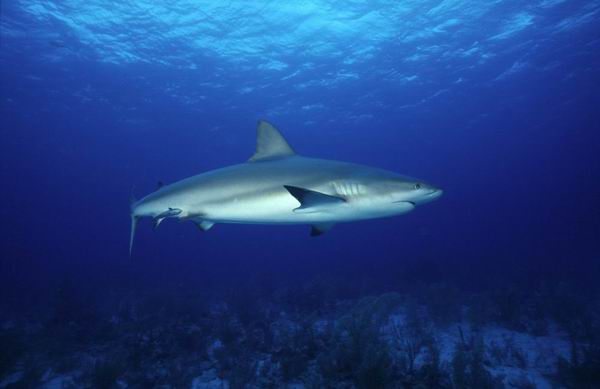
Photography:
My trip to the Bahamas was the very first time I’d ever shot underwater---outside
of a pool that is, it was the first time I’d ever used a Nikonos-V
camera, and it was the first time I’d ever dove with sharks. Thanks
to the scuba instructor back home who gave me a crash course in underwater
photography, with a somewhat different view on photography than what I
was used to, I was somehow able to pull it off…what is “field
of depth” anyway?
Now, photographing sharks can be, at best, a terrifying experience, especially
if you’ve watched far too many Jaws movies and have been “wrongly
convinced” that sharks are vicious man-eaters that enjoy snacking
on human flesh. I never really bought that crap, but the fear still rises
up from some unexplained place where all our brainwashing is kept, and
it was making me a little fearful at first.
Once I was in the water, armed with a bright orange Nikonos-V camera,
and there were, conservatively, 30 Caribbean reef sharks circling the
boat like Indians around a wagon in an old western, I began to really
panic. It didn’t take long to calm down, however, as the first few
sharks that came within petting distance (don’t try that) didn’t
eat me.
When that first shark did move within range—when I was down at 70
feet—I was thankful that the ladies who worked in the Stuart Cove
photo shop had already set the camera up with the strobe positioned to
the standard 45-degree angle to prevent backscatter (the light from the
strobe hitting suspended particles and bouncing back into the lens), had
pre-focused the lens for four feet from the subject, and had also given
me my second but very excellent course on underwater photography.
The rest of my photography experience over that week in the Bahamas was
pretty much trial and error. After each day of shark diving, I would get
my film developed back at the dock so I could view all the mistakes I’d
made. The following day I would try to correct those mistakes. The camera
was always set up at the photo shop, and so with little in-the-water adjustments
to be made, it was just a matter of remembering to shoot upwards a little
at the subject and trying to keep as close as possible to the sharks…thank
god you don’t have to shoot polar bears from such a close proximity.